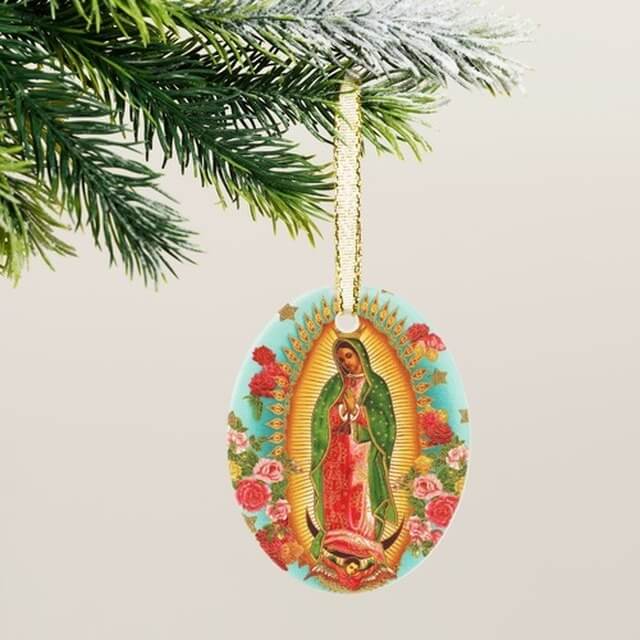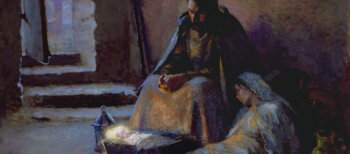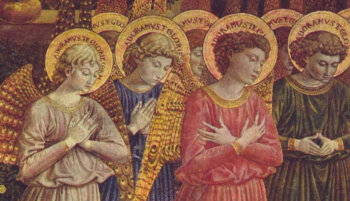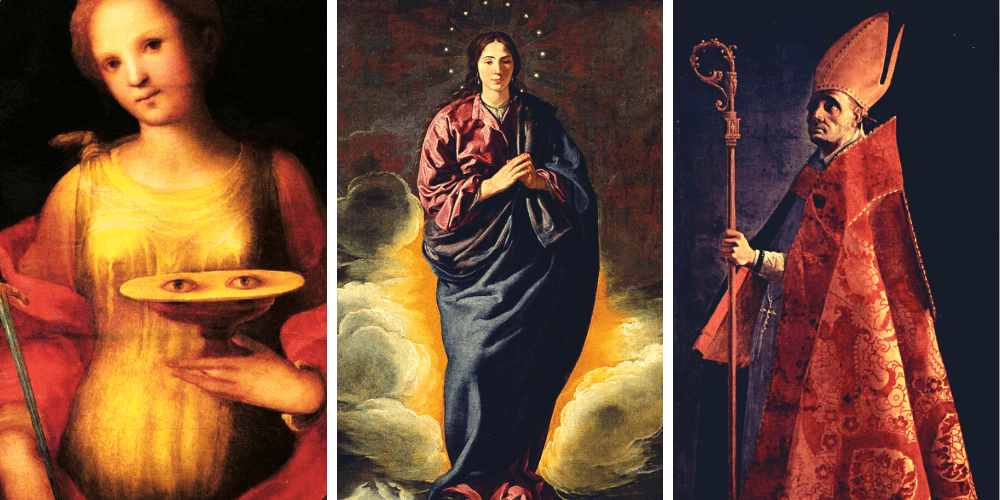
While much of the world starts celebrating Christmas the day after Halloween, Holy Mother Church draws us into the season of Advent. During Advent we prepare our hearts and our homes for the coming of the Christ Child at Christmas.
Traditionally a time of prayer, fasting, and almsgiving, Advent has been called a “little Lent.”
Unlike Lent, however, Advent is a penitential season that retains a gentle aura of festivity.
[W]hat ultimately distinguishes Advent from Lent is this: Advent has no Passion Week. Advent is both somber and festive because we are anticipating not suffering and death but rather the birth of a Child, which is always a joyful occasion. This Child is our long-awaited Messiah, the One who is coming to save us from the sins we are sorrowing over.
Genevieve Cunningham, Great Advent
Advent is a beautiful liturgical season—and within its four weeks are many wonderful saints and feasts to celebrate! Honoring these feast days can help us prepare ourselves to welcome Our Infant King on Christmas morning.
Of course, so many saints to honor during this liturgical season can seem a bit overwhelming—especially if we are also attempting to have a pensive season focused on preparing our hearts for the coming Savior.
Yet the feast days can be celebrated in easy ways without much effort, such as adding a prayer at the end of the day or having a meal based on the saint.
One of the beauties of celebrating Advent feast days is that it might look a little different for us each year. One year we might have a party to celebrate Our Lady of Guadalupe while another year we might have a lot more on our plate and all we can do is simply have a Mexican meal with our family to honor Our Lady.
There are many ways to simply—or elaborately—celebrate! Here are some suggestions.
1. St. Andrew (November 30)

The first saint to “kick off” the Advent season is St. Andrew. His feast is celebrated on November 30th.
Many Catholics are familiar with the the St. Andrew Christmas Novena. St. Andrew was the very first disciple called by Our Lord and the one who convinced his brother, Simon, to become Jesus’ disciple.
“We have found the Messiah!” Andrew said to his brother—who we now know as Peter, the first pope.
Andrew was a fisherman by trade but after hearing the call of Jesus, he committed his life to His teachings, left the fishing trade behind, and stayed with Jesus.
It is believed that after Jesus’ ascension, Andrew traveled to Greece to spread the gospel. He was eventually put to death on a cross to which he was tied. Although he suffered for two days before he died, he continued to preach the gospel from the cross he was tied to!
There are many popular traditions associated with St. Andrew’s feast day, especially in those countries which have him as their patron saint: Scotland and Russia.
But the most popular St. Andrew’s feast day tradition is for everyone: the Christmas novena that begins on his feast day.
While the origins of this prayer are unknown, it is over 100 years old (at least) and may have come from Ireland.
If the St. Andrew novena was prayed as a regular nine-day novena, it would end on the Feast of the Immaculate Conception on December 8th. However, this novena prayer is actually prayed much longer than nine days—it is prayed throughout all four weeks of Advent.
It is piously believed that whoever recites the St. Andrew Christmas Novena Prayer fifteen times each day from the feast of St. Andrew (November 30th) until Christmas Eve will obtain the favor requested.
Here is the novena prayer to St. Andrew:
Hail and blessed be the hour and moment in which the Son of God was born of the most pure Virgin Mary, at midnight, in Bethlehem, in piercing cold. In that hour, vouchsafe, O my God, to hear my prayer and grant my desires, through the merits of Our Saviour Jesus Christ, and of His Blessed Mother.
2. St. Nicholas (December 6)

St. Nicholas Day is on December 6th, and is an easy feast to celebrate with children.
To the delight of children’s hearts, their shoes—which are left out overnight—are filled with little chocolate coins or other candy and tiny treats. (See this article for ideas on how to celebrate this day with kids.)
While there are many wonderful stories about St. Nicholas, the most popular is the story of his generosity to a man whose three daughters could not afford the dowry needed to marry. Nicholas heard of tried to secretly leave three bags of gold at their home, so that the women could have a dowry and not be forced into prostitution by their poverty. A popular (but unsubstantiated) legend says that—when he tossed the gold into their home—it landed in their stockings, which is how the tradition of hanging one’s stockings came about.
The feast of St. Nicholas is also a perfect day for baking cookies. The traditional St. Nicholas cookies called speculass come from northern European countries such as Belgium, the Netherlands, and Germany. They are made using a detailed, hand-carved wooden cookie mold in the shape of the saint. Any cookie mold can be used to create beautiful “Christmas” cookies which are decorated with royal icing made from powdered sugar, real butter and vanilla, and then dyed with food coloring.
There are also a variety of cookie recipes which can be used such as a sugar cookie, peanut butter cookie, gingerbread cookie, or even store-bought cookie dough.
Another tradition that enhances the Advent spirit is to share your decorated cookies with neighbors, teachers, loved ones, or friends.
Reading a story about St. Nicholas in the evening is a wonderful way to end the day with young children (or grandchildren)!
Finally, don’t forget to invoke this great saint by reciting this prayer:
A Prayer to Saint Nicholas of Myra
O good St. Nicholas,
you who are the joy of children,
put into my heart a spirit of Christlike childhood,
which the Gospel exhorts us to have, and teach me to sow joy around me.
You, whose feast prepares us for Christmas,
open my faith to the mystery of God made Man.
You, good Bishop and Shepherd,
help me to unite my heart with the mission of Holy Mother Church,
and inspire her children to be faithful to the Gospel.
O good Saint Nicholas, patron of children, sailors and the helpless,
watch over those who follow Jesus, your Lord and theirs.
Bring us all in reverence to the Holy Child of Bethlehem,
when true joy and peace are found. Amen.
3. St. Ambrose (December 7)

When St. Ambrose was an infant, legend has it that a swarm of bees surrounded his face as he lay in his crib. Miraculously, none of the bees stung Ambrose, though a drop of honey was left on the infant’s cheek as they buzzed away.
Because of this sign, it was predicted that he would have a good disposition and a “honeyed tongue.”
Later his words would become wise counsel for many when the Church was suffering through the Arian heresy.
St. Ambrose was first appointed governor of Milan by the Emperor and then, after many heard his eloquent and powerful words, the people insisted that he be made bishop. This would have been fine if Ambrose had been a priest—but he was only a catechumen at the time and still preparing for baptism!
When he tried to decline the request to be bishop—he even went into hiding to avoid it—the Emperor, too, expressed his desire for Ambrose to become ordained so that he might be a bishop and forced him out of hiding. Within a week Ambrose was baptized a Christian, ordained a priest, and consecrated the bishop of Milan.
Many know of St. Ambrose as the one who taught, counseled, and converted St. Augustine. Both St. Augustine and St. Ambrose became the first doctors of the Church.
St. Ambrose is often seen with a beehive and is the patron saint of candlemakers, bee keepers, and bees. For this reason, many light a candle on this feast in honor of St. Ambrose. Another tradition is to make a dish or simple dessert with honey in it such as honey cakes.
Perhaps this is one of the feasts of Advent that you may wish to honor in a simple way such as lighting a candle (if possible, a beeswax one!) and saying the following prayer:
O Lord, who hast mercy upon all, take away from me my sins,
Penitential Prayer of St. Ambrose of Milan
and mercifully kindle in me the fire of thy Holy Spirit.
Take away from me the heart of stone, and give me a heart of flesh,
a heart to love and adore Thee, a heart to delight in Thee,
to follow and enjoy Thee, for Christ’s sake. Amen.
4. Feast of the Immaculate Conception (December 8)
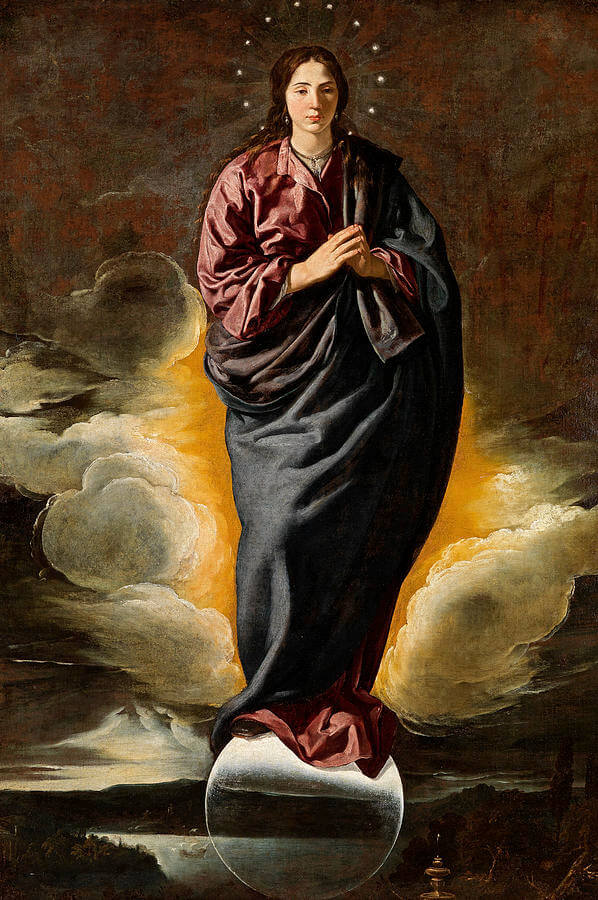
The Solemnity of the Immaculate Conception of the Blessed Virgin Mary (a Holy Day of Obligation) is December 8th.
This is one of the most important feast days on the Church calendar. Because Our Lady Immaculately Conceived is the patroness of the United States, it’s also a holy day of obligation in this country, which means that the faithful are required to attend Mass, as if it were Sunday.
The Church teaches that Mary was in need of salvation, the same as any human, for the gates of heaven were closed to mankind after the Fall. However, she was spared from original sin because God applied the graces of Her Son’s suffering to her preemptively (in other words, in advance—knowing that these graces would come to fruition) at the moment of her conception. Just as the redemptive power of Christ’s suffering is transported over time and space to each of us in Baptism, so too was this salvific power miraculously transported to Mary at the moment of her conception…
Peter Gohn, Full of Grace
It is for this reason [that] Mary was immaculately conceived.
Attending Mass as a family is a wonderful way to celebrate this feast day. Author Kendra Tierney says that, after Mass, she celebrates with her family by having a dinner of all white foods such as chicken alfredo, cauliflower, and white dinner rolls…and cake with white frosting for dessert.
A Marian procession or gathering for prayers is another simple way to honor Our Lady on her feast day. There are many traditional Marian prayers that might be said on this day such as the Litany of the Blessed Virgin Mary (also known as the Litany of Loreto).
The Collect from the Mass for this solemnity is also a beautiful prayer that can be recited:
O God, who by the Immaculate Conception of the Blessed Virgin prepared a worthy dwelling for your Son, grant, we pray, that you as you preserved her from every stain by virtue of the Death of your Son, which you foresaw, so through her intercession, we, too may be cleansed and admitted to your presence. Through our Lord Jesus Christ, your Son, who lives and reigns with you in the unity of the Holy Spirit, on God, for ever and ever. Amen.
Our Lady is an essential part of Advent and we can unite with her at the beginning of the season by asking for her intercession for a good and holy Advent!
5. The Feasts of Juan Diego (Dec. 9) and Our Lady of Guadalupe (Dec. 12)

The Feast of Juan Diego and the Feast of Our Lady of Guadalupe, which fall on separate days, can be celebrated in similar ways since we are—in essence—celebrating the same feast. To learn more about these feast days, you will find the full story of Juan Diego here and Our Lady of Guadalupe here.
The story of Juan Diego and Our Lady of Guadalupe has become an important part of the religious culture of the Americas and has inspired millions of conversions to the Catholic faith.
The image imprinted by Our Lady, despite being nearly 500 years old, shows no signs of deterioration. (The garment it was placed on is made of a material that deteriorates in twenty years and yet remains miraculously intact.)
If you have been fortunate enough to visit the Shrine in Mexico City, you have seen the incredible scenes of people dressed in traditional Aztec costumes, pilgrims on their knees moving towards the basilica, colorful paper flowers, and of course the tilma itself.
In Catholic All Year, author Kendra Tierney offers a wonderful idea to help celebrate the feast days:
If you are looking for something really great to celebrate St. Juan Diego and Our Lady of Guadalupe, you can’t do better than throwing a tamalada, in which different families bring different prepared elements and everyone hangs out while assembling and eating tamales. Enough tamales are made so that every family can bring some home for later.
Kendra Tierney, The Catholic All Year Compendium
Even if you don’t throw a party, you can easily and simply celebrate these feast days by preparing a traditional Mexican meal for your family or friends or by baking Mexican wedding cookies (sometimes referred to as “snowballs”) to enjoy these wonderful Catholic feasts.
You can also read or tell the story of Juan Diego and Our Lady of Guadalupe.
6. Feast of Our Lady of Loreto (December 10)
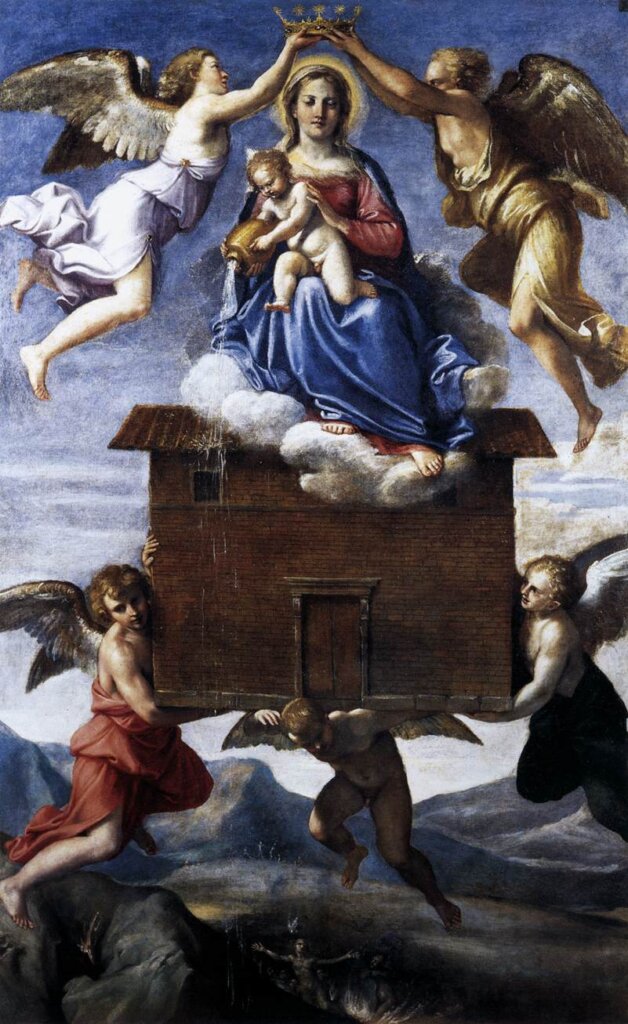
December 10th is the Feast of Our Lady of Loreto.
The origins of this title of Mary are interesting and worth learning more about. After Jesus’ Ascension, the Apostles converted Mary’s home in Nazareth into a chapel, which was discovered in 336 by St. Helena, mother of the Roman emperor Constantine.
A basilica was built around the house, and according to records, Christians worshipped there for more than a thousand years.
During later wars, Jerusalem and its surrounding area were being destroyed, and Our Lady’s home was threatened. So four angels picked up the house and moved it from Nazareth to a hill in Loreto, Italy, in 1295. Here pilgrims can visit the home today and see the basilica which was built around the small home.
While there is no requirement for Catholics to a have a devotion to Our Lady of Loreto, or to believe in the angelic transfer of the home (some say it was dismantled and brought to Loreto by ship), it is a wonderful tale! So much of our faith is rooted in mystery and this story is one way to express that mystery during Advent.
If you would like to learn more about this mysterious house being moved by angels, you will love this fascinating book on the subject.
It is also a perfect way to introduce the gingerbread house to your Advent tradition! Whether gingerbread “Loreto” houses are made from scratch or are store bought and decorated at home, they are a wonderful treat for this season!
7. St. Lucy’s Day (December 13)
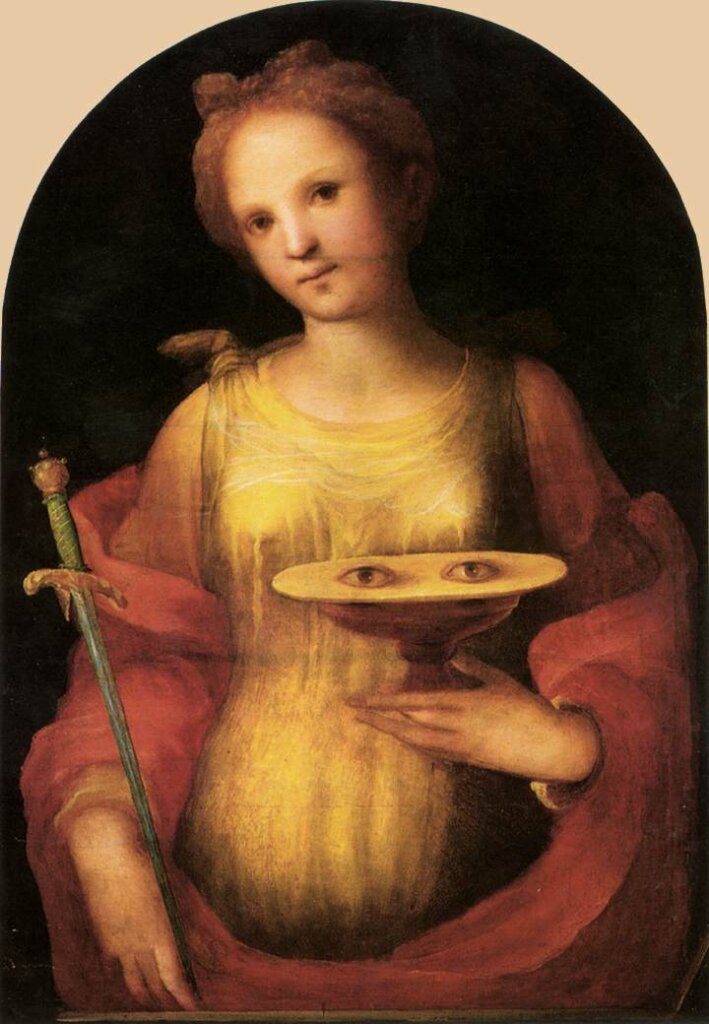
St. Lucy was one of seven holy women who, along with the Blessed Virgin Mary, are commemorated in the Canon of the Mass.
Born to wealthy Christian parents, Lucy lost her father when she was very young. Her mother then fell ill and, fearing that there would be no one to take care of her daughter if she died, she promised Lucy’s hand in marriage to a young pagan man from a noble family. St. Lucy prayed that her mother would be healed and then had a dream in which St. Agatha appeared to her and told her that her mother would survive because of her great faith.
In gratitude to God for this healing, Lucy and her mother decided to give all their fortune to the poor and to dedicate their lives to serving Christ. Lucy also declined to marry, preferring to consecrate herself to Jesus.
Upon hearing this, Lucy’s fiance became furious and denounced her to the Sicilian governor as a Christian. When the governor came to see for himself, Lucy looked at him and announced that he and Diocletian would be removed from power and dead within three years. This angered the governor so much that he had her eyeballs dug out and handed to her before her execution.
When Lucy’s body was prepared for burial, her eyes had been miraculously restored—so that her body entered the tomb intact. Furthermore, all that she had predicted came to pass. Just a few years later, the Roman Empire was under the rule of Constantine, who legalized Christianity in 313.
A favorite tradition for St. Lucy’s day is to make St. Lucy’s bread. This can be done in the form of a braided bread or as buns in an s-curl. Many recipes call for a raisin or two to be added to the center of each curl so that they look like eyeballs! This saffron-flavored sweet bread creates a lovely breakfast to be enjoyed on this feast day.
8. St. John of the Cross (December 14)

St. John of the Cross is considered one the greatest mystics of the Church. He lived in Spain in the 16th century and was known for his love of austerity and his devotion to Jesus Crucified.
Along with his friend and fellow mystic, St. Teresa of Avila, St. John of the Cross helped reform the Carmelite order, which had become somewhat lax in its practices and charism. Unfortunately, their attempts at reform were met with resistance. St. John of the Cross himself was imprisoned by a group of Carmelites who opposed his reforms. They locked him in a six-by-ten-foot cell. He was kept there for nine months, until he managed to escape by prying off a hinge on the door and climbing out through a window in the adjacent room.
During his imprisonment, St. John of the Cross wrote his “Spiritual Canticle of the Soul and the Bridegroom Christ” by the light of a small hole in the wall.
Kendra Tierney offers a few simple ways to celebrate this feast day:
For dinner, you can’t go wrong with a traditional Spanish soup. We like the Castilian sopa de ajo (garlic soup). It’s a tomato and garlic soup with ham and whole poached eggs…
For dessert I like to add to our Advent cookie stash by making peanut butter kisses. The brown peanut butter reminds us of the wooden cross, and the chocolate kiss on top is for the particular love St. John of the Cross had for it. (Brown and black are also the colors of the Carmelite habit).
Kendra Tierney, The Catholic All Year Compendium
Other Resources
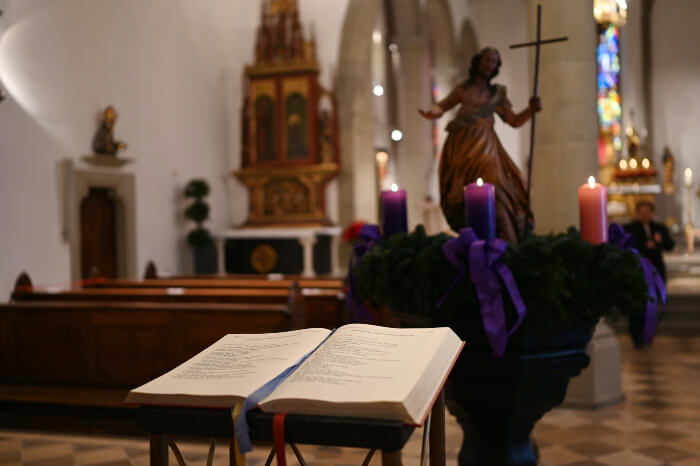
Honoring one or more or all of these feast days can bring re-focus our families on holy things as Christmas approaches. You can celebrate as simply or lavishly as you are able.
Looking for more Advent tips and guides?
You can discover so much more about the liturgical season of Advent (and all of the other seasons in the Catholic Church) in these Advent resources.
What are your favorite Advent traditions?
How does your family bring Advent into everyday life?
Which of these feast days are you going to celebrate?
We’d love to hear from you. Share your thoughts in the comment section below!
